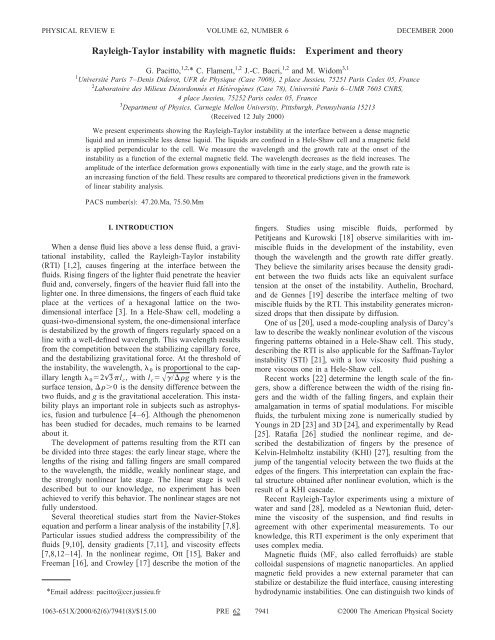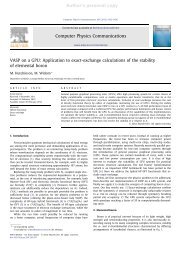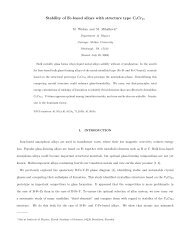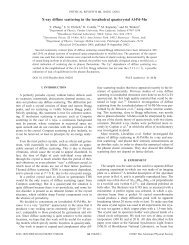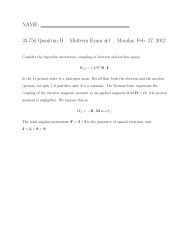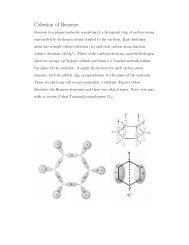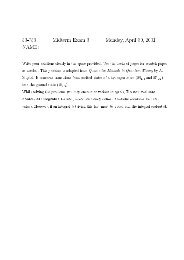Rayleigh-Taylor instability with magnetic fluids: Experiment and
Rayleigh-Taylor instability with magnetic fluids: Experiment and
Rayleigh-Taylor instability with magnetic fluids: Experiment and
You also want an ePaper? Increase the reach of your titles
YUMPU automatically turns print PDFs into web optimized ePapers that Google loves.
PHYSICAL REVIEW E VOLUME 62, NUMBER 6<br />
DECEMBER 2000<br />
<strong>Rayleigh</strong>-<strong>Taylor</strong> <strong>instability</strong> <strong>with</strong> <strong>magnetic</strong> <strong>fluids</strong>:<br />
<strong>Experiment</strong> <strong>and</strong> theory<br />
G. Pacitto, 1,2, * C. Flament, 1,2 J.-C. Bacri, 1,2 <strong>and</strong> M. Widom 3,1<br />
1 Université Paris 7–Denis Diderot, UFR de Physique (Case 7008), 2 place Jussieu, 75251 Paris Cedex 05, France<br />
2 Laboratoire des Milieux Désordonnés etHétérogènes (Case 78), Université Paris 6–UMR 7603 CNRS,<br />
4 place Jussieu, 75252 Paris cedex 05, France<br />
3 Department of Physics, Carnegie Mellon University, Pittsburgh, Pennsylvania 15213<br />
Received 12 July 2000<br />
We present experiments showing the <strong>Rayleigh</strong>-<strong>Taylor</strong> <strong>instability</strong> at the interface between a dense <strong>magnetic</strong><br />
liquid <strong>and</strong> an immiscible less dense liquid. The liquids are confined in a Hele-Shaw cell <strong>and</strong> a <strong>magnetic</strong> field<br />
is applied perpendicular to the cell. We measure the wavelength <strong>and</strong> the growth rate at the onset of the<br />
<strong>instability</strong> as a function of the external <strong>magnetic</strong> field. The wavelength decreases as the field increases. The<br />
amplitude of the interface deformation grows exponentially <strong>with</strong> time in the early stage, <strong>and</strong> the growth rate is<br />
an increasing function of the field. These results are compared to theoretical predictions given in the framework<br />
of linear stability analysis.<br />
PACS numbers: 47.20.Ma, 75.50.Mm<br />
I. INTRODUCTION<br />
When a dense fluid lies above a less dense fluid, a gravitational<br />
<strong>instability</strong>, called the <strong>Rayleigh</strong>-<strong>Taylor</strong> <strong>instability</strong><br />
RTI 1,2, causes fingering at the interface between the<br />
<strong>fluids</strong>. Rising fingers of the lighter fluid penetrate the heavier<br />
fluid <strong>and</strong>, conversely, fingers of the heavier fluid fall into the<br />
lighter one. In three dimensions, the fingers of each fluid take<br />
place at the vertices of a hexagonal lattice on the twodimensional<br />
interface 3. In a Hele-Shaw cell, modeling a<br />
quasi-two-dimensional system, the one-dimensional interface<br />
is destabilized by the growth of fingers regularly spaced on a<br />
line <strong>with</strong> a well-defined wavelength. This wavelength results<br />
from the competition between the stabilizing capillary force,<br />
<strong>and</strong> the destabilizing gravitational force. At the threshold of<br />
the <strong>instability</strong>, the wavelength, 0 is proportional to the capillary<br />
length 0 2)l c , <strong>with</strong> l c /g where is the<br />
surface tension, 0 is the density difference between the<br />
two <strong>fluids</strong>, <strong>and</strong> g is the gravitational acceleration. This <strong>instability</strong><br />
plays an important role in subjects such as astrophysics,<br />
fusion <strong>and</strong> turbulence 4–6. Although the phenomenon<br />
has been studied for decades, much remains to be learned<br />
about it.<br />
The development of patterns resulting from the RTI can<br />
be divided into three stages: the early linear stage, where the<br />
lengths of the rising <strong>and</strong> falling fingers are small compared<br />
to the wavelength, the middle, weakly nonlinear stage, <strong>and</strong><br />
the strongly nonlinear late stage. The linear stage is well<br />
described but to our knowledge, no experiment has been<br />
achieved to verify this behavior. The nonlinear stages are not<br />
fully understood.<br />
Several theoretical studies start from the Navier-Stokes<br />
equation <strong>and</strong> perform a linear analysis of the <strong>instability</strong> 7,8.<br />
Particular issues studied address the compressibility of the<br />
<strong>fluids</strong> 9,10, density gradients 7,11, <strong>and</strong> viscosity effects<br />
7,8,12–14. In the nonlinear regime, Ott 15, Baker <strong>and</strong><br />
Freeman 16, <strong>and</strong> Crowley 17 describe the motion of the<br />
*Email address: pacitto@ccr.jussieu.fr<br />
fingers. Studies using miscible <strong>fluids</strong>, performed by<br />
Petitjeans <strong>and</strong> Kurowski 18 observe similarities <strong>with</strong> immiscible<br />
<strong>fluids</strong> in the development of the <strong>instability</strong>, even<br />
though the wavelength <strong>and</strong> the growth rate differ greatly.<br />
They believe the similarity arises because the density gradient<br />
between the two <strong>fluids</strong> acts like an equivalent surface<br />
tension at the onset of the <strong>instability</strong>. Authelin, Brochard,<br />
<strong>and</strong> de Gennes 19 describe the interface melting of two<br />
miscible <strong>fluids</strong> by the RTI. This <strong>instability</strong> generates micronsized<br />
drops that then dissipate by diffusion.<br />
One of us 20, used a mode-coupling analysis of Darcy’s<br />
law to describe the weakly nonlinear evolution of the viscous<br />
fingering patterns obtained in a Hele-Shaw cell. This study,<br />
describing the RTI is also applicable for the Saffman-<strong>Taylor</strong><br />
<strong>instability</strong> STI 21, <strong>with</strong> a low viscosity fluid pushing a<br />
more viscous one in a Hele-Shaw cell.<br />
Recent works 22 determine the length scale of the fingers,<br />
show a difference between the width of the rising fingers<br />
<strong>and</strong> the width of the falling fingers, <strong>and</strong> explain their<br />
amalgamation in terms of spatial modulations. For miscible<br />
<strong>fluids</strong>, the turbulent mixing zone is numerically studied by<br />
Youngs in 2D 23 <strong>and</strong> 3D 24, <strong>and</strong> experimentally by Read<br />
25. Ratafia 26 studied the nonlinear regime, <strong>and</strong> described<br />
the destabilization of fingers by the presence of<br />
Kelvin-Helmholtz <strong>instability</strong> KHI 27, resulting from the<br />
jump of the tangential velocity between the two <strong>fluids</strong> at the<br />
edges of the fingers. This interpretation can explain the fractal<br />
structure obtained after nonlinear evolution, which is the<br />
result of a KHI cascade.<br />
Recent <strong>Rayleigh</strong>-<strong>Taylor</strong> experiments using a mixture of<br />
water <strong>and</strong> s<strong>and</strong> 28, modeled as a Newtonian fluid, determine<br />
the viscosity of the suspension, <strong>and</strong> find results in<br />
agreement <strong>with</strong> other experimental measurements. To our<br />
knowledge, this RTI experiment is the only experiment that<br />
uses complex media.<br />
Magnetic <strong>fluids</strong> MF, also called ferro<strong>fluids</strong> are stable<br />
colloidal suspensions of <strong>magnetic</strong> nanoparticles. An applied<br />
<strong>magnetic</strong> field provides a new external parameter that can<br />
stabilize or destabilize the fluid interface, causing interesting<br />
hydrodynamic instabilities. One can distinguish two kinds of<br />
1063-651X/2000/626/79418/$15.00 PRE 62 7941 ©2000 The American Physical Society
7942 G. PACITTO, C. FLAMENT, J.-C. BACRI, AND M. WIDOM<br />
PRE 62<br />
instabilities in ferro<strong>fluids</strong>: static instabilities caused by the<br />
<strong>magnetic</strong> field, which are not present in ordinary <strong>fluids</strong>; <strong>and</strong><br />
dynamic instabilities that appear or are modified by applied<br />
fields.<br />
The first static <strong>instability</strong> observed in MF is the peak <strong>instability</strong><br />
29. A static <strong>magnetic</strong> external field H ext applied<br />
tangent to a free surface generally stabilizes the surface.<br />
However, H ext applied normal to a horizontal surface causes<br />
the peak <strong>instability</strong> to rise above a critical value of H ext .A<br />
line in 2D or a lattice in 3D of spikes arises from the<br />
competition between the destabilizing <strong>magnetic</strong> forces <strong>and</strong><br />
the stabilizing capillary <strong>and</strong> gravitational forces.<br />
Now, let the MF be confined in a two-dimensional Hele-<br />
Shaw cell. Another <strong>instability</strong> can appear if the external field<br />
is applied in the direction perpendicular to the cell. This<br />
phenomenon, called the labyrinthine <strong>instability</strong> 30,31, occurs<br />
above a critical value of the applied field <strong>and</strong> <strong>with</strong> a<br />
critical wavelength. The threshold value of H ext results from<br />
a balance between the destabilizing <strong>magnetic</strong> dipole-dipole<br />
repulsion <strong>and</strong> the stabilizing surface tension <strong>and</strong> possibly<br />
gravity in a vertical cell.<br />
MF can be used as a dynamic system if a time-dependent<br />
<strong>magnetic</strong> field is applied. Different surface phenomena are<br />
observed such as surface waves 32,33, the Faraday <strong>instability</strong><br />
34, or a period doubling in the case of the peak <strong>instability</strong><br />
35.<br />
Hydrodynamic instabilities may occur when the MF<br />
flows. For example, Saffman-<strong>Taylor</strong> fingering has been studied,<br />
both experimentally <strong>and</strong> theoretically, <strong>with</strong> an MF. In<br />
this configuration, the external <strong>magnetic</strong> field can be applied<br />
normal to, or <strong>with</strong>in the plane of the cell. The situation is<br />
stabilizing if H ext is tangent to the interface <strong>with</strong>in the plane<br />
of the cell 36. <strong>Experiment</strong>s performed <strong>with</strong> a field applied<br />
in a direction perpendicular to a circular Hele-Shaw cell<br />
show a destabilizing behavior 37.<br />
The aim of this paper is to study the influence of a homogeneous<br />
<strong>magnetic</strong> field applied perpendicular to a vertical<br />
Hele-Shaw cell filled <strong>with</strong> a dense water-based ferrofluid<br />
above a lighter oil. In a recent paper 38, one of us describes<br />
theoretically the general viscous fingering pattern obtained in<br />
this configuration. In this dynamic situation, the <strong>magnetic</strong><br />
force is added to the gravitational force to destabilize the<br />
interface, while the capillary effects stabilize it.<br />
II. LINEAR STABILITY ANALYSIS<br />
Consider a vertical Hele-Shaw cell of gap h filled <strong>with</strong> oil<br />
of density <strong>and</strong> viscosity at the bottom <strong>and</strong> an immiscible<br />
MF of density <strong>and</strong> viscosity on top. We use a<br />
coordinate system in which the Hele-Shaw cell lies parallel<br />
to the xy plane, the y axis is vertically upward, <strong>and</strong> the z axis<br />
is perpendicular to the Hele-Shaw cell. Gravity acts downward<br />
parallel to the y axis <strong>and</strong> a uniform external <strong>magnetic</strong><br />
field H ext H ext ẑ, is parallel to the z axis see Fig. 1. We<br />
present equations of motion <strong>and</strong> boundary conditions <strong>and</strong><br />
then we perform a linear stability analysis of these equations.<br />
We show that both gravitational provided ) <strong>and</strong><br />
<strong>magnetic</strong> instabilities deform an initially flat interface.<br />
To begin, we derive Darcy’s law for the flow of MF. The<br />
analysis begins <strong>with</strong> the basic equation governing the threedimensional<br />
fluid flow v (x,y,z), the Navier-Stokes equation<br />
FIG. 1. The experimental setup consists in a cell located vertically<br />
between two coils. The external <strong>magnetic</strong> field obtained is<br />
horizontal <strong>and</strong> perpendicular to the cell. The cell that contains the<br />
both liquids can be rotated around a horizontal axis.<br />
Dv<br />
Dt pg v f m .<br />
From this equation, we derive Darcy’s law assuming sufficiently<br />
high viscosity so that the flow velocity is small, so<br />
the inertial term on the left-h<strong>and</strong> side may be neglected. The<br />
idea is to average Eq. 1 over the gap, resulting in a 2D flow<br />
equation for the gap-averaged velocity u . The gap average of<br />
the three-dimensional pressure gradient yields a twodimensional<br />
gradient of the gap-averaged pressure, which we<br />
continue to represent as p . As is usual in derivations of<br />
Darcy’s law, the gap average of the viscous drag force, subject<br />
to no-slip boundary conditions imposed at zh/2, is<br />
(12/h 2 )u .<br />
The final term in Eq. 1, f m 0 (M • )H , represents the<br />
<strong>magnetic</strong> body force on a fluid element, neglecting compressibility<br />
<strong>and</strong> self-induction of the fluid 39. In this approximation,<br />
M is constant <strong>and</strong> parallel to z, <strong>and</strong> the gap<br />
average of f m reduces to ( 0 M/h)H(x,y,h/2)H(x,y,<br />
h/2). Because the applied field H ext is spatially uniform,<br />
it drops out of this difference <strong>and</strong> the <strong>magnetic</strong> force arises<br />
entirely from the demagnetizing field H d H H ext caused<br />
by the surface <strong>magnetic</strong> poles. Express the demagnetizing<br />
field as the gradient of a <strong>magnetic</strong> scalar potential, H d <br />
(x,y,z), <strong>and</strong> take as an odd function of z. The gap<br />
average of the <strong>magnetic</strong> force is f m <br />
(2 0 M/h) (x,y,h/2), where now the gradient acts only<br />
on x <strong>and</strong> y coordinates 40.<br />
Collect all averaged terms <strong>and</strong> isolate the velocity u on<br />
the left-h<strong>and</strong> side,<br />
1<br />
12<br />
2M<br />
h 2 u pgŷ 0<br />
h x,y. 2<br />
Here all vectors lie in the xy plane, <strong>and</strong> the scalar potential<br />
(x,y)(x,y,h/2) is evaluated at the top plate. Further
PRE 62 RAYLEIGH-TAYLOR INSTABILITY WITH MAGNETIC ...<br />
7943<br />
simplification of Darcy’s law 2 occurs if we exploit the<br />
irrotational flow to introduce the velocity potential u <br />
so that<br />
12<br />
2M<br />
h 2 pgy 0 x,y. 3<br />
h<br />
Now we apply Darcy’s law 3 <strong>with</strong>in each fluid evaluated<br />
at the interface between the two <strong>fluids</strong>, y(x). Subtract<br />
Eq. 3 for the oil fluid from the same equation for<br />
MF fluid <strong>and</strong> find<br />
A <br />
2<br />
<br />
2<br />
<br />
h 2<br />
2M<br />
<br />
12 <br />
p<br />
p 0<br />
h<br />
h2 g<br />
12 <br />
for the viscosity contrast A( )/( ). The<br />
pressure jump across the interface, p p , is the surface<br />
tension times the mean interface curvature . For a thin<br />
gap h, we need only consider the curvature of (x), which<br />
we may approximate 2 /x 2 for the purpose of linear<br />
stability analysis 38.<br />
Represent the net perturbation (x,t) in the form of a<br />
Fourier mode<br />
x,t k tcoskx.<br />
The velocity potentials must obey Laplace’s equation<br />
2 0, because the <strong>fluids</strong> are incompressible. The boundary<br />
conditions at y→, so that 0. We give the<br />
appropriate wavevector <strong>and</strong> phase to be consistent <strong>with</strong> the<br />
perturbation . The general velocity potentials obeying these<br />
requirements are<br />
x,y,t k expkycoskx.<br />
In order to substitute expansions 6 into the equation of<br />
motion 4, we need to evaluate them at the perturbed interface.<br />
To first order in the perturbation, it suffices to simply<br />
set y0 in Eq. 6.<br />
To close Eq. 4 we need additional relations expressing<br />
the velocity potentials in terms of the perturbation amplitudes.<br />
To find these, consider the kinematic boundary condition<br />
that the interface moves according to the local fluid<br />
velocities. To first order in , we simply note /t<br />
i /y 38. Substituting Eq. 6 for <strong>and</strong> Fourier<br />
transforming yields ˙ kk k k k . Then Eq. 4 reads<br />
1<br />
k<br />
k<br />
t h 2<br />
2M<br />
12 <br />
k 2 <br />
k 0<br />
h<br />
h2 g<br />
12 k<br />
k<br />
To obtain the Fourier transform of the <strong>magnetic</strong> scalar<br />
potential, k , we write the <strong>magnetic</strong> scalar potential<br />
<br />
4<br />
5<br />
6<br />
7<br />
x,y M 4<br />
<br />
<br />
<br />
dx<br />
<br />
x<br />
1<br />
<br />
xx 2 yy 2 h 2.<br />
dy<br />
1<br />
xx 2 yy 2<br />
The expansion of „x,(x)… to first order in is<br />
x 0 M 1<br />
dx<br />
4 <br />
2<br />
1<br />
xx 2 xx 2 h<br />
xx<br />
<strong>and</strong> its Fourier transform k 2MJ(kh) k , where<br />
Jxlnx/2K 0 xC Euler<br />
8<br />
9<br />
10<br />
<strong>with</strong> where K 0 a Bessel function <strong>and</strong> C Euler 0.5772 ... is<br />
the Euler constant 41.<br />
Inserting k into Eq. 7 for the growth of the cosine<br />
mode, the differential equation of the interface is<br />
where<br />
˙ kk k ,<br />
kkV c B G 2B M Jkhkh 2 <br />
11<br />
12<br />
is the linear growth rate multiplying the first-order term in <br />
<strong>with</strong> V c /12( ) as the capillary velocity, B G<br />
( )gh 2 / the gravitational Bond number, <strong>and</strong><br />
B M <br />
0<br />
4 2M 2 h<br />
<br />
is the <strong>magnetic</strong> Bond number. An asymptotic expression for<br />
kh1 that is more convenient for the data analysis can be<br />
obtained by exp<strong>and</strong>ing J(kh) for small kh 42:<br />
Jkh kh2<br />
1C<br />
4<br />
Euler lnkh/2.<br />
III. EXPERIMENTAL SETUP<br />
13<br />
The experimental geometry is sketched in Fig. 1. The cell<br />
is located in a gap between two coils in the Helmholtz configuration<br />
to achieve good axial homogeneity for the <strong>magnetic</strong><br />
field H ext . The radial homogeneity of the field is better<br />
than 3%. The amplitude of the external field is nearly constant.<br />
The cell is mounted so it can be rotated around the x<br />
axis, which passes through the middle of the gap.<br />
We use an ionic <strong>magnetic</strong> fluid made of cobalt ferrite<br />
particles (CoFe 2 O 4 ) dispersed in a mixture of water <strong>and</strong><br />
glycerol. This MF is synthesized by Neveu 43 following<br />
the Massart’s method 44. The magnetization of the MF as a<br />
function of H ext is obtained by the use of a calibrated<br />
fluxmeter.<br />
The rectangular cell consists of two parallel plates made<br />
of altuglass Plexiglas <strong>with</strong> a spacing between the two plates<br />
of h500 m. The cell is initially filled <strong>with</strong> an oil White<br />
Spirit or WS of low density compared to the MF that wets
7944 G. PACITTO, C. FLAMENT, J.-C. BACRI, AND M. WIDOM<br />
PRE 62<br />
FIG. 2. Several pictures of the destabilizing MF-WS interface<br />
for different times a t0; b t5 s; c t8 s; d t11 s for<br />
H ext 7.9 kA/m. The gray bar equals 1 cm.<br />
the altuglass walls. A thin film of micron width of WS<br />
separates the MF from the walls, avoiding pinning of the<br />
MF-WS contact line on the walls.<br />
The mass density of MF is 168685 kg m 3 , compared<br />
to 800 kg m 3 for WS. The dynamic viscosity of<br />
the MF is 0.14 kg m 1 s 1 at room temperature. The<br />
viscosity of the WS is two orders of magnitude lower, so we<br />
may take 0.<br />
Image processing is used to measure the wavelength <strong>and</strong><br />
the growth increment. The images are recorded by a CCD<br />
camera charge-coupled device <strong>and</strong> digitized by an acquisition<br />
card in a computer. We use the public domain software<br />
NIH Image 45 to analyze the images.<br />
IV. RESULTS<br />
A. Wavelength measurements<br />
The experiments are conceptually simple: the cell is<br />
placed vertically <strong>with</strong> the heavier liquid MF below. We<br />
rotate the cell by 180° around the x axis <strong>and</strong> apply the <strong>magnetic</strong><br />
field. The selected wavelength depends on how <strong>and</strong><br />
when the <strong>magnetic</strong> field is applied. If H ext is applied during<br />
the rotation, we get a different measurement than if H ext is<br />
switched on at the end of the rotation. The response of the<br />
MF-WS interface to the <strong>magnetic</strong> field is usually much faster<br />
than its response to a gravitational field. That is, a longer<br />
time is needed to observe the classical RTI <strong>with</strong>out an external<br />
<strong>magnetic</strong> field than to observe the labyrinthine <strong>instability</strong><br />
30,31. IfH ext is applied during rotation when the cell is<br />
momentarily horizontal, the normal field <strong>instability</strong> 29 appears<br />
before the RTI. To avoid these difficulties, we apply<br />
the field only after the rotation is complete, but before the<br />
RTI appears. The duration of rotation is about 1 s, <strong>and</strong> the<br />
time constant for ramping up the <strong>magnetic</strong> field is less than 1<br />
s.<br />
We collected data for 13 different values of H ext , <strong>with</strong><br />
two independent runs for each value of H ext . The wavelength<br />
0 2/k 0 , is measured at the onset of the <strong>instability</strong><br />
until the amplitude of the interface deformation remains<br />
small: k 0 0.1. We compared two different methods: a FFT<br />
of the interface gives the fundamental mode k 0 , a direct<br />
measurement of the average peak to peak distance gives 0 .<br />
In the second approach, we reject the peaks located close to<br />
the edges of the cell, <strong>and</strong> we omit certain peaks that are<br />
dominated by others ‘‘finger competition’’. Both methods<br />
give similar results <strong>with</strong>in the errors bars.<br />
FIG. 3. Several destabilizing interfaces for different values of<br />
the applied field a H ext 4.1 kA/m <strong>and</strong> t8 s; b H ext<br />
11.9 kA/m <strong>and</strong> t9 s; c H ext 17.8 kA/m <strong>and</strong> t6 s; H ext<br />
31.6 kA/m <strong>and</strong> t1 s. The gray bar equals 1 cm.<br />
Figure 2 displays a sequence of pictures of the destabilizing<br />
MF-WS interface for H ext 7.9 kA/m. A comparison of<br />
interfaces for different values of the external field is shown<br />
in Fig. 3. Both the wavelength <strong>and</strong> the width of the MF<br />
fingers decrease as H ext increases. The experimental values<br />
of 0 as a function of the external field H ext are reported in<br />
Fig. 4.<br />
To compare experimentally observed wavelengths <strong>with</strong><br />
the linear stability analysis, consider the growth rate, (k).<br />
Maximizing expression 12 for (k) versus the wavevector,<br />
gives the fastest growing mode k 0 :<br />
<br />
k<br />
0⇔ 0 2<br />
.<br />
k<br />
kk 0 0<br />
We get the following nonalgebraic equation:<br />
B G<br />
4 2 x 0 2 B M a 3 2 lnx 0 30,<br />
14<br />
<strong>with</strong>, a1 3 2 C Euler 3 2 ln()0.79, <strong>and</strong> x 0 0 /h. To<br />
determine the value of<br />
FIG. 4. Wavelength as a function of the external applied field<br />
H ext . <strong>Experiment</strong>al data are measured by the direct peak-to-peak<br />
method, at the onset of the <strong>instability</strong>.
PRE 62 RAYLEIGH-TAYLOR INSTABILITY WITH MAGNETIC ...<br />
7945<br />
B M 0 2M 2 h<br />
4 <br />
for a given value of H ext , we need to know the MF-WS<br />
surface tension . The value of can be deduced from the<br />
wavelength at the onset of the RTI <strong>with</strong> H ext 0 using formula<br />
12. Wefind8.63.8 mN m 1 by this method. We<br />
can also determine the value of from the wavelength at the<br />
threshold of the normal field <strong>instability</strong>, which is linked <strong>with</strong><br />
the capillary length 46. This method yields 12.0<br />
1.3 mN m 1 , which is closed to the previous value. The<br />
value of the magnetization M(H ext ) is directly deduced from<br />
the magnetization curve of the MF. Taking the latter value of<br />
, we deduce a capillary length l c 0.12 cm, <strong>and</strong> the gravitational<br />
Bond number B G 0.18. The roots of Eq. 14 are<br />
reported in Fig. 4 for comparison <strong>with</strong> the experimental data.<br />
Both are qualitatively coherent. We get a good agreement for<br />
low values <strong>and</strong> high values of H ext . The discrepancy for the<br />
intermediate values should result from the omission of the<br />
demagnetizing effect in the <strong>magnetic</strong> forces.<br />
To take into account this demagnetizing effect, we have to<br />
consider an infinite plane <strong>with</strong> an external field applied perpendicular<br />
to the plane. The demagnetizing factor is equal to<br />
D1. Consequently, the local field is: H H ext DM <br />
H ext M . The magnetization M , is linked to the local<br />
field by the relation M H , it leads to M (/1<br />
)H ext . A local susceptibility can be determined by the<br />
use of the magnetization curve: (H ext )M(H ext )/H ext 47,<br />
<strong>and</strong> subsequently a <strong>magnetic</strong> Bond number including the demagnetizing<br />
effect is<br />
B M 0 2M 2 h<br />
4 <br />
We can calculate the contribution of the demagnetizing effects<br />
to the theoretical roots. The results are also shown in<br />
Fig. 4. The experimental values are between the theoretical<br />
predictions D0 demagnetizing effects neglected <strong>and</strong> D<br />
1 demagnetizing effects maximized. An exact calculation<br />
would have to deal <strong>with</strong> the nonuniform fringe fields at<br />
the edge of a para<strong>magnetic</strong> slab.<br />
B. Growth rates<br />
Now, let us study the growth rate of the <strong>instability</strong>. We<br />
measure the length of the falling fingers, <strong>and</strong> divided by<br />
0 (tt 0 ); t 0 corresponds to the first time where the interface<br />
deformation is detectable <strong>and</strong> is actually given by the<br />
resolution of the video recorder. We use a direct measurement<br />
of the length instead of a Fourier analysis since it gives<br />
results <strong>with</strong> a huge scattering. Moreover, we have checked<br />
that both methods give similar results <strong>with</strong>in the error bars<br />
for the wavelength at the onset of the RTI. Plotting this relative<br />
depth to which the <strong>instability</strong> penetrates the lighter fluid<br />
as a function of time, we can clearly separate two distinct<br />
stages Fig. 5.<br />
Just after the onset of the <strong>instability</strong>, when the amplitude<br />
of the growth the length of the spikes is small compared to<br />
the wavelength, we see an exponential growth over time.<br />
This occurs for all values of the external applied field. We<br />
FIG. 5. Growth rates for H ext 23.6 kA/m in the exponential<br />
regime <strong>and</strong> in the linear regime shown in the inset as a function of<br />
time.<br />
observe an augmentation in the growth rate values as the<br />
field increases, as is predicted by the linear analysis given by<br />
the formula 12. In this equation, the growth rate is a function<br />
of H ext <strong>and</strong> also a function of x 0 . As we have seen in<br />
the previous part, x 0 is an implicit function of H ext , <strong>and</strong> we<br />
cannot find an explicit expression of (H ext ). Nevertheless,<br />
Eq. 12 can be written<br />
*<br />
B<br />
˜ M<br />
15<br />
<strong>with</strong> the growth rate for the mode of wavelength 0 hx 0 in<br />
the absence of <strong>magnetic</strong> field<br />
* b x 0<br />
B G<br />
4 2 x 0<br />
2<br />
<strong>and</strong> a characteristic inverse of time<br />
˜ b<br />
2x 0<br />
3 aln x 0 .<br />
We define b2 3 /3 h <strong>and</strong> a1C Euler ln <br />
0.72, <strong>and</strong> x 0 is defined previously.<br />
If we insert the theoretical values of the wavelength x 0 th ,<br />
in the expressions of * <strong>and</strong> ˜ we can compare the theoretical<br />
linear analysis to the experimental measurements of<br />
exp .<br />
These experimental results of the growth rate exp measured<br />
near the onset of the <strong>instability</strong> for different values of<br />
the external applied field are shown in Fig. 6, where we plot<br />
( exp *)/˜ versus the <strong>magnetic</strong> Bond number. The theoretical<br />
continuous line results from the linear analysis Eq.<br />
15 <strong>and</strong> is the first bisectrix of the Fig. 6. The experimental<br />
results are below the theoretical curve, but are included in<br />
the error bars. These experimental uncertainties are large due<br />
to the difficulty of measuring the amplitude .<br />
To reduce the systematic discrepancy between the two<br />
curves, we can, as <strong>with</strong> the wavelength treatment, take into<br />
account the demagnetizing field effect. The plot of ( exp<br />
*)/˜ versus B M is also reported in Fig. 6. In contrast to<br />
the previous case, the data are above the first bisectrix. Since
7946 G. PACITTO, C. FLAMENT, J.-C. BACRI, AND M. WIDOM<br />
PRE 62<br />
FIG. 6. Magnetic field dependence of the growth rate; black<br />
circles represent the experimental data see text <strong>with</strong>out demagnetizing<br />
effects; white squares maximize the demagnetizing effects in<br />
the expression of the <strong>magnetic</strong> Bond number.<br />
we have crudely included the demagnetizing fields through a<br />
demagnetizing factor D1, the demagnetizing effects are<br />
naturally overestimated, <strong>and</strong> this explains the intermediate<br />
position of the theoretical prediction between the points <strong>with</strong><br />
D0 <strong>and</strong> the ones <strong>with</strong> D1. A fully three-dimensional<br />
calculation is needed to properly treat the demagnetization<br />
fields at the MF-WS interface.<br />
After the initial exponential growth of the disturbances,<br />
we enter a new growth regime shown in the inset of Fig. 5. A<br />
linear growth is observed for each value of the applied <strong>magnetic</strong><br />
field. This behavior is observed for long times, up to<br />
the secondary instabilities, where the finger tips split <strong>and</strong><br />
start to compete <strong>with</strong> each other. As the <strong>magnetic</strong> field increases,<br />
we observe an increase in the linear coefficient. For<br />
example, for H ext 0, we get 0 1.92.0(tt 0 ), <strong>and</strong><br />
for H ext 39.3 kA/m, we get 0 10.820.1(tt 0 ).<br />
Saturation of the exponential growth is predicted by weakly<br />
nonlinear analysis 38. Crossover from exponential to linear<br />
has been found in numerical simulations for non<strong>magnetic</strong><br />
<strong>fluids</strong> 51.<br />
C. Far from the threshold<br />
This study emphasized the downward propagating MF<br />
fingers, but upward fingers made of WS also exist. As a<br />
matter of fact, the heavier liquid, i.e., the MF, falls down due<br />
to the buoyancy forces <strong>and</strong> consequently, the lighter liquid<br />
that is the less viscous fluid has to penetrate into the viscous<br />
one. A finger of WS grows between each spike of MF. These<br />
WS fingers rise like the ST finger propagating in a narrow<br />
channel 21. In fact, both instabilities RTI <strong>and</strong> STI can be<br />
described by the same set of equations 38. The width of the<br />
WS fingers is greater than the MF fingers, but a common<br />
feature is that the width is a decreasing function of the external<br />
<strong>magnetic</strong> field. Such a symmetry breaking of the interface<br />
is related to the viscosity contrast between MF <strong>and</strong><br />
WS 38.<br />
The tip of the WS fingers splits into two fingers the socalled<br />
‘‘tip-splitting’’ phenomenon <strong>and</strong> the angle between<br />
these new fingers is roughly equal to 90°. The evolution of<br />
the system exhibits a cascade of tip splitting: each new finger<br />
divides itself into two fingers that destabilize themselves<br />
while they remain upward. Let us notice that the finger<br />
FIG. 7. Pictures of the RTI far from the threshold see text <strong>and</strong><br />
for high value of the applied field: H ext 40 kA/m. The black bar<br />
equals 1 cm.<br />
changes its direction slightly after each tip splitting: it seems<br />
to undulate like a narrow finger confined in a channel in the<br />
‘‘oscillating-tip’’ regime 48. No other secondary <strong>instability</strong><br />
such as the ‘‘side-branching’’ phenomenon is observed. The<br />
tip-splitting cascades acting on a finger give a pattern that<br />
looks like a tree as it is illustrated in Fig. 7. This pattern is<br />
somewhat similar to the radial viscous fingering obtained<br />
<strong>with</strong> the STI 37 <strong>with</strong> the difference that the system is anisotropic<br />
due to the gravity field.<br />
The MF fingers always remain stable because the viscosity<br />
contrast is opposite a viscous fluid penetrating a less<br />
viscous one is stable situation. When the MF fingers are<br />
sufficiently far from each other <strong>and</strong> for high values of the<br />
<strong>magnetic</strong> field, a bending <strong>instability</strong> occurs 49. When the<br />
distance between the fingers is comparable to the finger<br />
width, long range <strong>magnetic</strong> interactions between fingers are<br />
visible: they undulate together for high <strong>magnetic</strong> field in the<br />
same manner than the MF parallel stripes in the bending<br />
<strong>instability</strong> 50. Finally, the pattern is very non-symmetric<br />
Fig. 7b because of all these features. For high amplitudes<br />
of the external field <strong>and</strong> at long times the top of the cell<br />
becomes a labyrinthine <strong>and</strong> the bottom is rather well organized<br />
as the MF smectic 50.<br />
At very long times, the MF accumulates in the bottom of<br />
the cell, displacing the WS to the top. The limiting pattern is<br />
a conventional MF labyrinth 39 <strong>with</strong> a reservoir MF at the<br />
bottom of the cell Fig. 8. We investigated whether a hierarchical<br />
dynamical behavior 52 emerges because of the<br />
treelike structure of highly bifurcated fingers of WS. Retraction<br />
of bifurcated fingers cannot occur because their points of<br />
bifurcation represent points of force balance <strong>and</strong> are therefore<br />
immobile. To undo a bifurcation requires retraction of at<br />
least one of the branches inset of Fig. 8. However, each<br />
branch may itself be bifurcated, further slowing down the<br />
pattern evolution. Only at finger tips are forces unbalanced<br />
<strong>and</strong> dynamics unfrozen. Hierarchically constrained dynamics<br />
leads to glassy behavior 52. A Kohlrausch stretched expo-
PRE 62 RAYLEIGH-TAYLOR INSTABILITY WITH MAGNETIC ...<br />
7947<br />
V. CONCLUSION<br />
FIG. 8. Final state of the RTI at high fields H ext 40 kA/m. In<br />
the inset, intermediate stage evolution of the RTI at long time: a<br />
Arrow points to branched finger about to disappear. b 0.5 s later,<br />
one branch has retracted. c 4 s later, the entire finger disappears.<br />
The black bar equals 1 cm.<br />
nential law should govern the evolution in this regime. However,<br />
our experiments are consistent <strong>with</strong> a conventional exponential<br />
behavior, at least at short times. In particular, we<br />
measured the total interface contour length as a function of<br />
time. Over a period of 120 s it fits well to an exponential<br />
relaxation <strong>with</strong> a time constant of 25 s.<br />
We perform the <strong>Rayleigh</strong>-<strong>Taylor</strong> <strong>instability</strong> experiment<br />
using <strong>magnetic</strong> fluid. Near the onset of the <strong>instability</strong>, to<br />
describe the pattern, we measure, for different values of the<br />
<strong>magnetic</strong> field, the wavelength <strong>and</strong> the growth rate of the<br />
observed fingers. The <strong>magnetic</strong> field destabilizes the interface,<br />
decreasing the wavelength <strong>and</strong> increasing the growth<br />
rate as it is predicted by the linear analysis of the ferrohydrodynamics<br />
equations. We get a good agreement between<br />
experiments <strong>and</strong> theory. At long times, a comparison <strong>with</strong><br />
numerical simulations for different values of the fields will<br />
be of great interest. Other experiments can be performed<br />
using a <strong>magnetic</strong> field applied parallel to the interface in<br />
order to stabilize the interface.<br />
ACKNOWLEDGMENTS<br />
We are greatly indebted to Sophie Neveu for providing us<br />
<strong>with</strong> the <strong>magnetic</strong> fluid <strong>and</strong> Patrick Lepert for building the<br />
experimental device. We acknowledge useful discussions<br />
<strong>with</strong> Jose Mir<strong>and</strong>a <strong>and</strong> support by the National Science<br />
Foundation Grant No. DMR-9732567.<br />
1 Lord <strong>Rayleigh</strong>, Scientific Papers II Cambridge University<br />
Press, Cambridge, Engl<strong>and</strong>, 1900, p. 200.<br />
2 G. I. <strong>Taylor</strong>, Proc. R. Soc. London, Ser. A 201, 192 1950.<br />
3 M. Fermigier, L. Limat, J.-E. Weisfreid, P. Boudinet, <strong>and</strong> C.<br />
Quilliet, J. Fluid Mech. 236, 349 1992.<br />
4 D. H. Sharp, Physica D 12, 31984.<br />
5 L. Smarr, J. R. Wilson, R. T. Barton, <strong>and</strong> R. L. Bowers, Astrophys.<br />
J. 246, 515 1981.<br />
6 H. J. Kull, Phys. Rep. 206, 197 1991.<br />
7 S. Ch<strong>and</strong>rasekhar, Hydrodynamic <strong>and</strong> Hydro<strong>magnetic</strong> Stability<br />
Oxford University Press, Oxford, 1961, Chap. X.<br />
8 R. Menikoff, R. C. Mjolsness, D. H. Sharp, C. Zemach, <strong>and</strong> B.<br />
J. Doyle, Phys. Fluids 21, 1674 1978.<br />
9 M. Mitchner <strong>and</strong> R. K. M. L<strong>and</strong>shoff, Phys. Fluids 7, 862<br />
1964.<br />
10 M. S. Plesset <strong>and</strong> D-Y. Hsieh, Phys. Fluids 7, 1099 1964.<br />
11 R. LeLevier, G. J. Lasher, <strong>and</strong> F. Bjorklund, Lawrence Livermore<br />
Laboratory Report No. UCRL-4459, 1955 unpublished.<br />
12 R. Menikoff, R. C. Mjolsness, D. H. Sharp, <strong>and</strong> C. Zemach,<br />
Phys. Fluids 20, 2000 1977.<br />
13 K. O. Mikaelian, Phys. Rev. E 47, 375 1993.<br />
14 A. Elgowainy <strong>and</strong> N. Ashgriz, Phys. Fluids 9, 1635 1997.<br />
15 E. Ott, Phys. Rev. Lett. 29, 1429 1972.<br />
16 L. Baker <strong>and</strong> J. R. Freeman, S<strong>and</strong>ia National Laboratories Report<br />
No. S<strong>and</strong>80-0700, 1980 unpublished.<br />
17 W. P. Crowley, Lawrence Livermore Laboratory Report No.<br />
UCRL-72650, 1970 unpublished.<br />
18 P. Petitjeans <strong>and</strong> P. Kurowski, C. R. Acad. Sci. Paris 325, 587<br />
1997.<br />
19 J.-R. Authelin, F. Brochard <strong>and</strong> P.-G. de Gennes, C. R. Acad.<br />
Sci. Paris 317, 1539 1993.<br />
20 J. A. Mir<strong>and</strong>a <strong>and</strong> M. Widom, Int. J. Mod. Phys. B 12, 931<br />
1998.<br />
21 P. G. Saffman <strong>and</strong> Sir G. I. <strong>Taylor</strong>, Proc. R. Soc. London, Ser.<br />
A 245, 312 1958.<br />
22 S. I. Abarzhi, Phys. Fluids 11, 940 1999.<br />
23 D. L. Youngs, Physica D 12, 321984.<br />
24 D. L. Youngs, Phys. Fluids A 3, 1312 1991.<br />
25 K. I. Read, Physica D 12, 451984.<br />
26 M. Ratafia, Phys. Fluids 16, 1207 1973.<br />
27 P. Gondret <strong>and</strong> M. Rabaud, Phys. Fluids 9, 3267 1997.<br />
28 A. Lange, M. Schröter, M. A. Scherer, A. Engel, <strong>and</strong> I. Rehberg,<br />
Eur. Phys. J. B 4, 475 1998.<br />
29 M. D. Cowley <strong>and</strong> R. E. Rosensweig, J. Fluid Mech. 30, 671<br />
1967.<br />
30 A. Cebers <strong>and</strong> M. M. Maiorov, Magn. Gidrodin. 1, 127 1980;<br />
3, 151980.<br />
31 R. E. Rosensweig, M. Zahn, <strong>and</strong> R. Shumovich, J. Magn.<br />
Magn. Mater. 39, 127 1983.<br />
32 T. Mahr <strong>and</strong> I. Rehberg, Phys. Rev. Lett. 81, 891998.<br />
33 J. Browaeys, J.-C. Bacri, C. Flament, S. Neveu, <strong>and</strong> R. Perzynski,<br />
Eur. Phys. J. B 9, 335 1999.<br />
34 J.-C. Bacri, A. Cebers, J.-C. Dabadie, S. Neveu, <strong>and</strong> R.<br />
Perzynski, Europhys. Lett. 27, 437 1994.<br />
35 J.-C. Bacri, U. d’Ortona, <strong>and</strong> D. Salin, Phys. Rev. Lett. 67, 50<br />
1991.<br />
36 M. Zahn <strong>and</strong> R. E. Rosensweig, IEEE Trans. Magn. 16, 275<br />
1980.<br />
37 C. Flament, G. Pacitto, J.-C. Bacri, I. Drikis, <strong>and</strong> A. Cebers,<br />
Phys. Fluids 10, 2464 1998.<br />
38 M. Widom <strong>and</strong> J. Mir<strong>and</strong>a, J. Stat. Phys. 93, 411 1998.<br />
39 R. W. Rosensweig, Ferrohydrodynamics, Cambridge University<br />
Press, Cambridge, Engl<strong>and</strong>, 1985.<br />
40 D. P. Jackson, R. E. Goldstein, <strong>and</strong> A. O. Cebers, Phys. Rev. E<br />
50, 298 1994.<br />
41 A. O. Cebers, Magnetohydrodynamics 16, 236 1980.<br />
42 H<strong>and</strong>book of Mathematical Functions, edited by M. Abrahamovitz<br />
<strong>and</strong> I. A. Stegun Dover, New York, 1965, p. 375.<br />
43 S. Neveu from the Laboratoire des Liquides Ioniques et Interfaces<br />
Chargées, located at University Paris 6.
7948 G. PACITTO, C. FLAMENT, J.-C. BACRI, AND M. WIDOM<br />
PRE 62<br />
44 R. Massart, IEEE Trans. Magn. 17, 1247 1981.<br />
45 NIH Image by Wayne Rasb<strong>and</strong>, National Institutes of Health<br />
available at http://rsb.info.nih.gov/nih-image/.<br />
46 C. Flament, S. Lacis, J.-C. Bacri, A. Cebers, S. Neveu, <strong>and</strong> R.<br />
Perzynski, Phys. Rev. E 53, 4801 1996.<br />
47 We use (H ext )M/H ext instead of M/H because it is not<br />
possible to measure directly the internal <strong>magnetic</strong> field.<br />
48 Y. Couder, N. Gerard, <strong>and</strong> M. Rabaud, Phys. Rev. A 34, 5175<br />
1986.<br />
49 J.-C. Bacri, A. Cebers, C. Flament, S. Lacis, R. Melliti, <strong>and</strong> R.<br />
Perzynski, Prog. Colloid Polym. Sci. 98, 301995.<br />
50 C. Flament, J.-C. Bacri, A. Cebers, F. Elias, <strong>and</strong> R. Perzynski,<br />
Europhys. Lett. 34, 225 1996.<br />
51 G. Tryggvason <strong>and</strong> H. Aref, J. Fluid Mech. 154, 287 1985.<br />
52 R. G. Palmer, D. L. Stein, F. Abrahams, <strong>and</strong> P. W. Anderson,<br />
Phys. Rev. Lett. 53, 958 1984.


